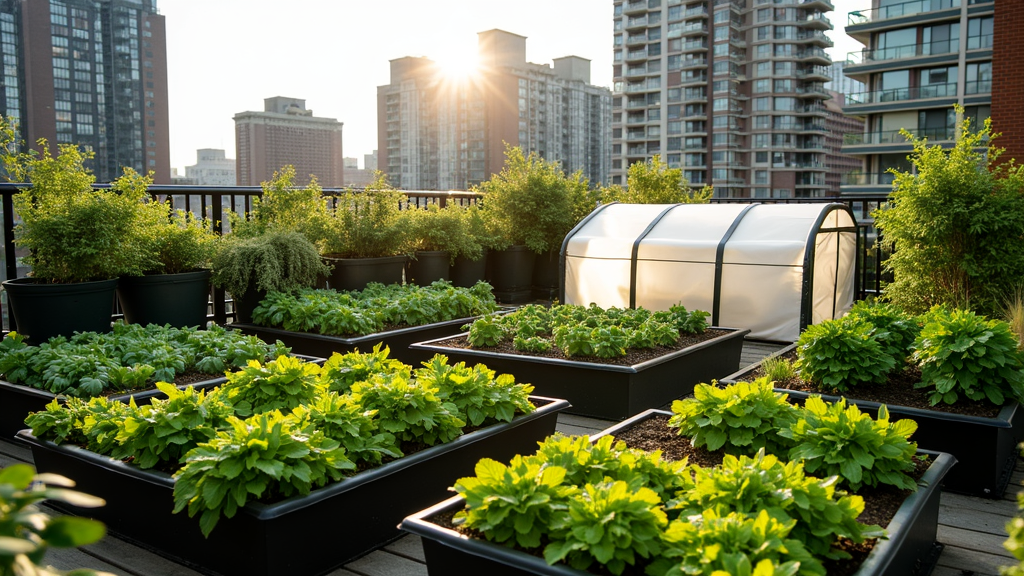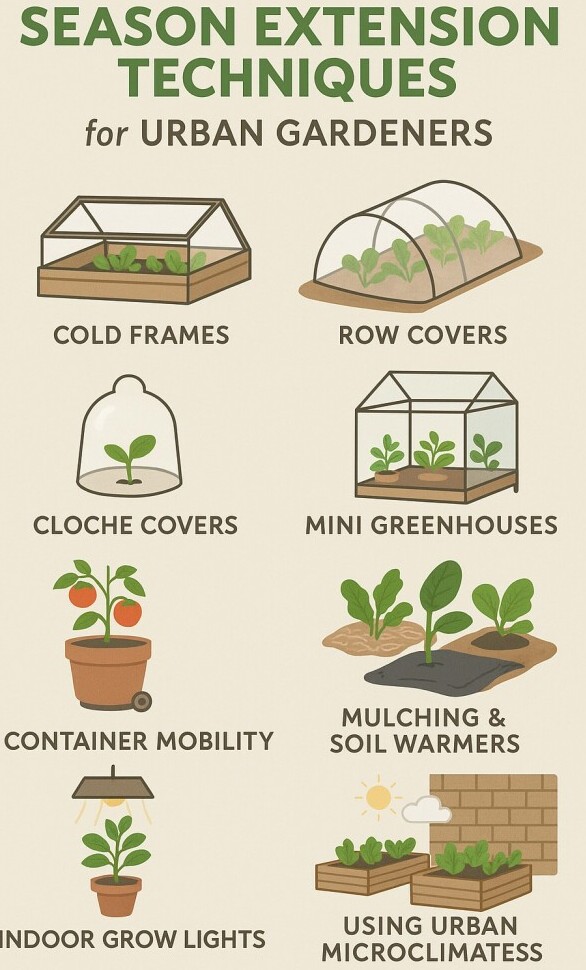Urban gardening is gaining popularity every year, and I’ve found that one of the biggest game changers is learning how to extend the growing season. No matter if you grow on a balcony, rooftop, windowsill, or in a tiny backyard, there are simple techniques that let you enjoy homegrown produce for more months out of the year. Here’s how you can keep that fresh harvest rolling well past the usual limits.

Unlocking Urban Season Extension
When you think about growing food in the city, it’s easy to assume the planting window is short. Plant in the spring, harvest by late summer, and then wait until the following year. That used to be my mindset, too, but after experimenting with a few simple tricks that anyone can do, I’ve managed to push the harvest further into the fall and even jumpstart things early in the spring.
Extending the growing season doesn’t require expensive gear or a full backyard. A little creativity and some household items are often all you need. This approach is efficient for city dwellers with limited space, as it allows you to focus your efforts on smaller plots or containers that are easier to cover and protect. Plus, extending the growing season helps you spread out harvests, avoid pest pressure in peak summer, and enjoy leafy greens long after most folks pack away their trowels.
Cold Frames: Your Urban Mini Greenhouse
Cold frames are one of my favorite tools for keeping leafy greens, such as lettuce, spinach, and herbs, thriving during the cooler weather. A cold frame is a box with a transparent lid and no bottom. Imagine an old window set in a wooden frame, acting like a mini-greenhouse. It traps heat from the sun during the day and retains it through chilly nights, giving your plants a significant head start in spring or a prolonged stretch in late fall.
In urban spaces, cold frames are convenient because they can be placed directly on top of existing beds, a raised planter, or even on pavement. If you’ve got an old window or transparent plastic sheets, you can build one yourself by simply propping it up over a few cinder blocks or wooden boards. I’ve seen them on tiny balconies and tucked into rooftop nooks, so even a small cold frame can expand what you can grow and for how long.
Cold frames are best for crops that thrive in the cooler seasons. Think greens, radishes, carrots, and hardy herbs. You can open the frame on sunny days to let in fresh air and prevent overheating (yes, that happens, even in cool months!), then close it up as the sun sets to lock in the warmth for the night.
Row Covers and Low Tunnels: Easy Frost Protection
Row covers are another practical and budget-friendly method for pushing the growing season on patios, balconies, or raised beds. They’re lightweight sheets made out of spun fabric. Brands like Agribon or Reemay are common, but you’ll also spot DIY versions made from old bedsheets or clear plastic. The fabric lets in sunlight and rain but blocks out frost, wind, and even some pesky bugs.
Setting up is simple: hoop a few flexible rods (such as wire, bamboo, or small PVC pipes) over your beds or containers, drape the fabric over them, and secure the edges with clips, rocks, or bricks. Row covers come in a “floating” style that rests on top of plants, or as structured low tunnels for a little extra height.
This is one of my go-to tricks for early spring sowings or when the weather looks dicey in fall. Just cover your plants at night and peel them back when temperatures warm up during the day. Row covers work great for cool-season veggies, such as arugula, kale, and beets, which are perfect for urban gardens as they don’t take up much space and can be grown in containers, as well as for newly transplanted seedlings, and they barely take up extra room. That’s a big win in city plots.
Cloche Covers: Tiny Greenhouses for Individual Plants
If you’ve ever wished you could just put a warm hat on your tomato starts or protect a precious seedling from a cold snap, cloche covers are for you. These bell-shaped covers, traditionally made of glass but now often plastic, protect individual plants from chilly temps, wind, and even hungry critters like birds or curious squirrels.
You don’t need to drop money on fancy cloches, either. I’ve used cut clear plastic bottles, old jars, or even large glass bowls, and they all work surprisingly well. Slip them over a single plant at dusk, remove in the morning for air circulation, and repeat as needed. They fit great on busy windowsills, tight planters on balconies, or anywhere space is limited and you want to give a little extra TLC to your plants.
Cloche covers are super handy for getting early beans, cucumbers, or even peppers established, as they provide a warm and protected environment for these heat-loving plants. They are also helpful in shielding tender herbs if you have a frosty forecast. For a quick and easy hack, save your 2-liter soda bottles, cut off the bottoms, and pop them over young seedlings. Remember to open the tops during the day so excess moisture escapes and your plants don’t get too humid.
Mini Greenhouses: Going Vertical and Modular
Many city dwellers don’t have the space for a full-size greenhouse, but small-scale options are widely available and surprisingly effective. Vertical mini-greenhouses resemble shelving units wrapped in clear plastic, featuring zippered doors for easy access. They’re designed to fit into tight spots. Think against a sunny fence, tucked into a corner on a rooftop, or even indoors near a window.
I like these for starting seeds when winter is still hanging on, or for growing fresh herbs and microgreens right through January. The clear covers hold in humidity and warmth, so your plants don’t get thirsty or chilled. When the weather turns for the better, it’s easy to collapse the greenhouse or move it out of the way to free up space.
With a mini greenhouse, it’s entirely possible to keep lettuce, spinach, and even dwarf tomatoes or peppers growing in containers all year round, as long as you pay attention to light and ventilation. Some people even use bubble wrap as extra insulation, which helps keep heat in during bitter nights and chilly mornings.
Container Mobility: Move With the Weather
Containers are the backbone of urban gardening. One of the best perks? You can pick them up and move! Shift your pots against a south-facing wall to catch radiant heat, or wheel a planter inside when a frost warning is issued. If you spot a cold snap approaching, group your containers and drape them with a blanket or row cover at night to share communal warmth.
I always keep my most cold-sensitive plants and newest transplants in portable containers if I’m expecting late-spring or early-fall chills. Concrete patios, brick walls, and sunny decks all retain heat, so placing containers right next to them provides your plants with a small but beneficial microclimate. Plus, the soil in pots tends to warm up earlier in the season than inground beds, which helps seeds sprout before outdoor beds are even workable.
Mulching and Soil Warmers: Root Protection for Urban Plots
Mulch is a real all-purpose tool for gardeners. By blanketing your soil with organic materials like straw, chopped leaves, or grass clippings, you retain warmth and moisture during chilly nights. This is particularly important in containers, as they lose heat more quickly than a large patch of ground.
For an extra boost, I sometimes use black plastic as a soil warmer. It reflects sunlight, cooking the soil a few degrees warmer and keeping roots happier well into fall or even during surprise cold spells in spring. Lay the plastic over the surface (cutting holes for your plants), or tuck it around your containers for the same effect.
Try mulching with at least a couple of inches of material around your plants, especially in late summer or before the first frost is due. This small effort can mean the difference between losing and saving a crop during a cold front. If you’re out of mulch, even shredded newspaper or cardboard can do in a pinch.
Indoor Grow Lights: Harvest Indoors, Any Time
Once you realize your apartment or kitchen can be a winter salad factory, there’s no going back. Full-spectrum LED grow lights make it easy to grow leafy greens, fresh herbs, or even start seeds for your next season, regardless of what’s happening outside your window.
Quality LED grow lights sip electricity and fit neatly over shelves or desks. The trick is to make sure your plants get the right amount of light, usually at least 1214 hours a day for good growth. I set up a basic timer and don’t have to think about it again for the rest of the winter. You can even stagger light times for different types of crops to maximize your harvest year-round.
This technique is practical for anyone with a windowsill or countertop. You’ll be surprised how fast basil or baby kale grows indoors once you get the hang of the watering and light setup. Plus, there’s something about fresh herbs in winter that feels like cheating the system.
Using Urban Microclimates: City Heat Islands
Cities have their built-in climate perks, and with a bit of observation, you can spot areas that stay warmer, are less windy, or get more sun than the norm. Watch for sunny walls, corners shielded from the breeze, or exposed rooftops that soak up sunlight. These spots are perfect for earlier or longer growing of tomatoes, peppers, and other warmth-loving crops.
In my place, herbs planted near a brick wall consistently survive later into fall, while salad greens on the east-facing rooftop wake up earlier than the rest of the garden in spring. Paying attention to these warm zones lets you stretch the calendar without doing anything fancy. Sometimes it’s just about placing the right pot in the right place to give your plants a head start or extra protection.
Some urban gardeners even use water-filled jugs painted black to absorb heat during the day and gradually release it at night. This is a straightforward solar heating trick that works equally well on patios, balconies, and rooftop gardens.
Step by Step Guide: How to Get Started with Season Extension
Breaking into season extension isn’t complicated. Here’s a basic outline to get you up and running, primarily focused on what works for tight urban spaces:
- Start Small: Begin with a few pots, a planter box, or a raised bed so you’re not overwhelmed. Select easy-to-grow cool-season crops, such as spinach, radishes, or lettuce.
- Choose Your Technique: Decide what fits your space and needs. A mini-greenhouse suits your balcony, or a few cold frames tucked against a sunny wall.
- Gather Your Supplies: Save old windows, plastic bottles, fabric scraps, or even cardboard. Urban gardening rewards creativity, not high budgets. Ask friends or neighbors for unused supplies to help get started.
- Time Your Plantings: Use cold frames to sow early in spring or to stretch out fall crops. When using grow lights, you can start seeds indoors in late winter for a head start.
- Keep Up With Weather: Watch the forecast for frost dates, hot spells, or possible wind events. Have fabric row covers or extra mulch on hand for backup. City microclimates can sometimes be unpredictable, so it helps to check in daily.
- Monitor for Pests: Many season extension techniques help keep insects out, but check under covers or in mini-greenhouses regularly to make sure nothing’s snuck in. Natural pest controls, such as neem oil or handpicking, are adequate if problems are caught early.
- Adjust As Needed: Crack open cold frames on warm days. Roll up row covers when it’s sunny so your plants don’t overheat. Containers may require different watering schedules as the weather changes. Keep an eye on your garden and adjust as needed.
Common Urban Gardening Challenges (and Solutions)
Season extension offers numerous benefits, but you may encounter some issues along the way. Here are the biggest hurdles and how I usually handle them:
- Space Constraints: Compact tools (cold frames, mini-greenhouses) and creative use of vertical space mean even a small balcony can host a surprising variety of crops.
- Temperature Fluctuations: City weather is unpredictable. Quick-response covers (such as row covers or cloches) make it easy to guard against sudden dips.
- Light Availability: Tall buildings might shade your garden late or early in the season. Indoor grow lights or strategically placed reflective surfaces can make a significant difference.
- Pest Buildup: Covers help, but pests can sneak in. Rotate crops, clean up dead leaves, and check under covers weekly for uninvited guests.
- Limited Storage: Foldable greenhouses, stackable pots, and lightweight row cover materials store easily when not in use. Consider hanging storage on walls or fences for tools and accessories.
Advanced Tips for Getting the Most Out of Your Urban Garden
If you want to make your setup even more effective, try these tricks I’ve picked up after a few years of trial and error:
Layering Covers: Stack a row cover inside a mini-greenhouse, or combine cloches with cold frames for double insulation. This method is beneficial during harsh cold snaps in late fall or early spring.
Succession Sowing: Instead of planting all your seeds at once, sow small amounts every week or two. This maintains a continuous supply of harvestable crops, even in the face of unexpected weather changes.
Water Wisely: Covered beds and containers may dry out more slowly or faster, depending on the weather. Check soil moisture with your finger. Most leafy greens prefer a consistently moist environment, but not one that is too wet or soggy.
Reflective Materials: Foil-lined cardboard or old mirrors can bounce sunlight into shady corners, warming up cold frames or mini-greenhouses in the low-light months.
Crop Choice: Focus on proven cool-hardy varieties. Look for seed packets labeled “cold tolerant” or “quick maturing.” There are spinach, radish, and lettuce varieties that are specifically bred for shoulder seasons. Herbs like cilantro and parsley also thrive in cooler temperatures.
Try root vegetables in containers. Things like baby carrots or small beets thrive when started a bit early and given protection during unpredictable weather swings.

Real Urban Experiences: What Works in the City
I’ve chatted with city gardeners from all over the country, and there’s a lot of common ground. Everyone has a hack or tip that fits their microclimate and available square footage.
- One balcony gardener in Chicago uses 2-liter soda bottles as cloches and harvests arugula in December. These homemade covers also deter squirrels and help the soil warm up quickly in the morning.
- My friend in San Francisco lines her mini-greenhouse with leftover bubble wrap for extra insulation, then grows basil until January. She swears by morning misting to keep humidity up on dry days.
- On my rooftop, it’s all about staking row covers over a bed of kale in late October. We’re still pulling leaves for salads after Thanksgiving, and even a little snow rarely knocks the plants back if the cover is tight and anchored.
It’s straightforward once you experiment and keep notes. Plants respond well to even the smallest extension techniques, and you’ll soon find what fits your location, time, and style. Journal your results season to season so you can tweak your strategy each year for bigger and better yields.
Frequently Asked Questions
Question: Can I use season extension if I only have a windowsill or a tiny balcony?
Answer: Definitely. Mini-greenhouses, cloche covers made from jars or bottles, and grow lights all work well in small spaces. Even just moving pots inside or near a warm window helps to accelerate the season’s progress. If you use a south-facing window and supplement with a grow light, you can get salad greens all winter long.
Question: What’s the easiest crop to grow with season extension?
Answer: Leafy greens, such as lettuce, spinach, and arugula, respond exceptionally well to cold frames and row covers. They germinate in cooler soils and recover quickly from chilly nights. Try also green onions or radishes for quick, rewarding crops.
Question: Are there low-cost ways to start season extension?
Answer: Yup! Save clear takeout containers, plastic bottles, old windows, or scrap fabric. DIY cloches and cold frames cost almost nothing and work surprisingly well for minor crops. Please don’t hesitate to ask local cafes or restaurants for extra containers. Neighbors often have spare items, such as bricks or old sheets, that can be put to use. Putting it All Together: Enjoying a Longer Harvest.

Urban season extension feels magical once you realize how flexible it can be. With a bit of planning and the proper setup, whether it’s a cold frame on the patio, pots you can roll onto a sunny ledge, or a set of grow lights above the kitchen sink, you’ll be picking herbs, greens, and root veggies earlier in spring and later into fall than your neighbors ever thought possible. Try a few of these ideas and see which ones fit your routine, your space, and the types of crops you love most. Your harvest basket will thank you! As you become more confident, you might even inspire neighbors or friends to try out these tricks, forming a small community of gardeners who share their bounty. Happy gardening and enjoy every bite of your more extended harvest!